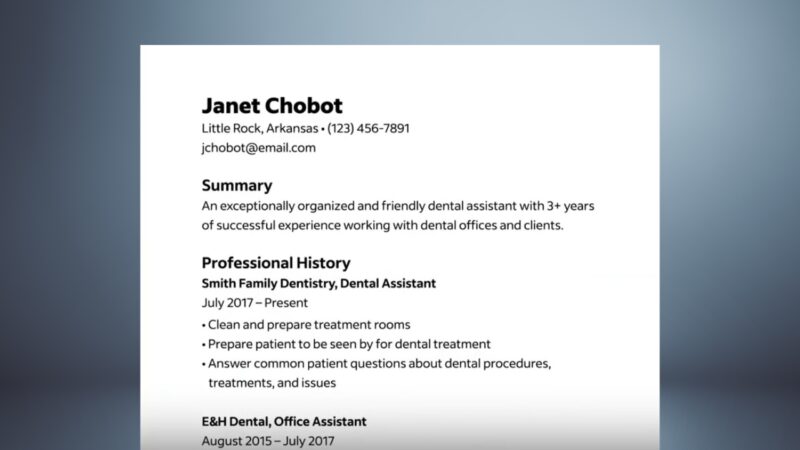Crafting a resume that stands out is crucial, especially when nearly 40% of hiring managers devote less than a minute to its review.
An effective resume highlights one’s skills and qualifications compellingly, ensuring it catches the reader’s eye swiftly.
This guide will explore the essential components of creating a professional resume that can secure interviews.
It will include step-by-step instructions and examples tailored for various job roles and unique situations.
Crafting a Resume for a Job

Organize Your Career Details
Creating an outstanding resume begins with thorough preparation. It is vital to collect all relevant career details before writing to ensure a compelling and comprehensive resume.
- Identify Achievements: Document achievements from previous roles. Quantifiable results, such as sales targets met or projects completed, can demonstrate your effectiveness.
- Skills Inventory: List all soft, hard, and technical skills. Ensure these match the desired skills in the job description. For example, if the job calls for project management, mention your expertise in tools like Trello or Asana.
- Previous Workplaces: Provide details of past employers, including company names, job titles, locations, and employment dates. A summary of key responsibilities held in each position should also be included.
- Academic Background: Include your educational credentials. Mention degrees, certifications, or licenses that validate your qualifications.
- Volunteer Experiences: If relevant, add volunteer work. Volunteering can showcase pertinent skills and experiences that align with the job’s requirements.
- Awards and Recognitions: Highlight any awards or honors received. These accolades can reinforce your resume by indicating dedication and competence.
Reviewing this compiled information against the job description will help in crafting a tailored resume. Using similar language to the job posting enhances the relevance of your application, increasing the likelihood of catching the employer’s attention. Customizing each resume is a vital strategy to stand out in the application process.
Choose the Right Resume Format

Selecting the appropriate resume format is crucial for effectively showcasing your qualifications. Different formats suit various career stages and professional goals.
- Chronological Format: This is the most traditional and commonly used resume format. It emphasizes work history and is ideal for candidates with a consistent job history and no significant employment gaps. By listing work experiences in reverse chronological order, it highlights career progression and stability.
- Functional Format: This format is skill-centric and is particularly beneficial for individuals entering the workforce, changing careers, or having employment gaps. It focuses on skills and expertise rather than the chronological order of work history. It’s an effective way to demonstrate the value you bring through your abilities and training.
- Combination Format: Also known as the hybrid format, this option merges the strengths of both the chronological and functional formats. It is ideal for those with significant experience (typically over ten years) and those aspiring to progress in their career. The combination format provides a balanced view of your skills while also highlighting relevant work experiences.
Each format has its strengths and should be chosen based on individual career backgrounds and objectives. By carefully selecting the suitable format, candidates can present their qualifications in the best possible light, aligning with employer expectations.
Add Your Contact Details
Showcasing contact information is crucial so that hiring managers can easily reach out. Below are essentials to include:
- Full name
- Reliable phone number
- Professional email address
- City, state, and ZIP code
- Link to a professional social media profile, personal website, or portfolio if applicable
Example:
Stefan Mihajlovic | 555-555-5555 | Chicago, IL
[email protected]
Write an Engaging Summary

A resume summary provides a concise, impactful overview of your qualifications, skills, and career goals. It should grab the reader’s attention and make them want to read more. Avoid clichés and focus on what makes you unique.
Example:
Efficient, accuracy-driven secretary was successful at delivering key clerical support to internal teams, customers, vendors, and other stakeholders. Demonstrated success in analytical problem-solving and boosting operational efficiency. Bringing 10 years of superior performance in related roles.
For first-time job seekers, career changers, or those returning after a long break, a resume objective focused on the company’s needs can be used instead.
Example:
As a medical assistant wanting to transition into a project manager role, my career objective is to leverage my strong organizational skills, attention to detail, and ability to work collaboratively to lead projects from conception to completion effectively.
Create a Resume Work Experience Section
Employers want to see how your experience has prepared you for the role you’re applying for. List your work experience in reverse chronological order, starting with your most recent position.
For each job, include the job title, company name, location, employment dates, and 3-5 bullet points highlighting your achievements and responsibilities. Quantify your accomplishments to provide tangible evidence of your impact.
Example: Secretary | BCforward – Huston, TX | 08/2015 – Current
- Conducted thorough research to assist professional staff with various projects.
- Provided clerical support to 200 employees by managing documents.
- Produced accurate office files and presentations to boost team efficiency.
Use strong action verbs like “Accelerated,” “Designed,” and “Initiated” to make your statements more impactful.
Highlight Skills in the Skills Section
A well-rounded skills section should include both hard and soft skills relevant to the job. Aim to list six to eight key skills. For those without work experience or changing careers, focus on transferable skills such as communication and critical thinking.
Example Skills:
- Project Management
- Data Analysis
- Communication
- Time Management
- Leadership
- Technical Proficiency
Accurately List Your Educational Background
Your educational background is an important part of your resume. Include the following information for each educational institution:
- Name of the school or university
- Location (city and state)
- Graduation or expected graduation month and year
- Degree and program name
Example: Columbia University, New York, NY\
May 2014\
Bachelor of Science in Social Work
If recently graduated or without much work experience, include relevant coursework, GPA (if above 3.5), and any honors or awards.
Include Relevant Certifications, Licenses, and Training

For certain professions, certifications and licenses are mandatory. Include any relevant certifications, licenses, and completed training programs that enhance your qualifications for the job.
Example Certifications:
- Certified Public Accountant (CPA)
- Project Management Professional (PMP)
- AWS Certified Solutions Architect
Add Extra Resume Sections if Applicable
Creating a compelling resume goes beyond the basics. Including optional sections like volunteer work, awards, honors, and publications can distinguish your resume from others. Incorporating these elements highlights your achievements and can make you a more attractive candidate.
For those with published works or significant awards, integrating these can enhance your profile, showcasing your accomplishments to potential employers. If these achievements are closely tied to your education or profession, they can be seamlessly included in relevant sections rather than creating new ones.
For example, awards tied to your degree can be listed as bullet points under the education section or within the work history if they are job-related. If space allows, a dedicated section for awards, honors, or publications can be added below the education section, listing items in reverse chronological order.
Volunteer work demonstrates your commitment to community service and your interests outside of work. Employers value these traits. Typically, volunteer experience is included towards the bottom of the resume to maintain focus on professional experience. Use a clear heading like “Volunteer Experience” and describe roles with bullet points similar to how work history is formatted.
For those with limited professional experience, relevant volunteer activities can be included in the work history section. Clearly label such roles as volunteer positions, for example, “Volunteer Program Manager.”
Be selective when adding optional qualifications to your resume. Given the limited space of a one- or two-page document, each included item should add significant value. Below the education or certifications section, list optional credentials with bullet points detailing the names and dates earned or published.
Review, Ensure Correct Formatting, and Save
Typos and grammatical errors are common mistakes that can be a deal-breaker for hiring managers. Ensuring your resume is error-free is crucial. Thorough proofreading is necessary to verify all information, such as dates and company names, is accurate. Using tools like the spell-check feature in the Resume Builder can help catch mistakes.
Formatting is another critical aspect. Hiring managers prefer resumes that are easy to read. Here are some formatting tips:
- Keep it concise: A one-page resume is usually sufficient unless you have over ten years of experience. In that case, two or three pages are acceptable.
- Set proper margins: Use 1-inch margins on all sides. If more space is needed, margins can be reduced to a minimum of half an inch.
- Use professional fonts: Choose fonts like Times New Roman, Arial, or Helvetica.
- Font size: Use a font size between 10-12 points for the body and 14-16 points for headings.
- Line spacing: Opt for single or 1.5-point line spacing.
- Save in the correct format: Save your resume as a PDF or DOCX file. Some employers specify which format to use, so always follow their instructions. PDF is a safe choice if no specific format is required.
- File naming: Name your resume file aptly, e.g., “FirstName_LastName_Resume.pdf.” Including the company name or job title can further organize your files.
These practices ensure the resume is professional, making a favorable impression on hiring managers.
Create a Matching Cover Letter
To complement your polished resume, a compelling cover letter is indispensable. It gives you the chance to provide detailed information about your professional background and aspirations. Additionally, a cover letter can effectively address any gaps in your employment history or shifts in your career path.
To begin, consider using a professional cover letter template that aligns with the aesthetic of your resume. Personalizing your cover letter by addressing the hiring manager by name can add a personal touch and demonstrate your dedication.
A strong cover letter might include:
- Introduction: Capture interest with a compelling opening.
- Body: Detail your relevant experiences, skills, and career ambitions.
- Conclusion: Reiterate your enthusiasm, summarize your qualifications, and include a call to action.





















